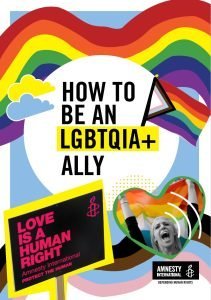The answers revealed
Keep an eye on your phone – we’ll be in touch to send you your LGBTQIA+ ally guide!

This guide presents simple and practical advice for all of us, as we strive to better support the LGBTQIA+ people in our lives and challenge discrimination facing the LGBTQIA+ community. Together, we can help build a safer, kinder and more equal world where human rights are enjoyed by all, regardless of who we love, how we dress or how we identify.
Question 1: When and where was the first Mardi Gras in Australia?
Answer: a. The first March was held in 1978 in Sydney/Gadigal land. Back then it was known as the Sydney Gay Solidarity March and was organised to mark the anniversary of the 1969 Stonewall riots in New York. Today the Sydney Gay and Lesbian Mardi Gras is one of the largest pride parades in the world!
Question 2: True or false? The 1978 Mardi Gras ended with violent attacks by NSW police and over 50 people arrested.
Answer: a. True. Although the marchers were issued a permit, the NSW Police suddenly stopped the march, confiscating speakers and arresting people. Many more were brutally attacked. The Sydney Morning Herald covered the event by publishing the names of people who had been arrested and some people were fired from their jobs and even disowned by family. It would take decades for the NSW Police and the Sydney Morning Herald to apologise for the hurt and pain caused by their actions in 1978.
Question 3: Mardi Gras is about spectacle, colour and fun, but what else does it represent?
Answer: d. All of the above and much more. Mardi Gras and Pride mean lots of different things to members of the LGBTQIA+ community. Here are some of the things that Mardi Gras represents:
- Creating a safe space for pride, diversity and self-expression
- Paying tribute to the courage and bravery of LGBTQIA+ people who have fought for the rights and visibility queer people have today
- Finding a sense of belonging and connection as the LGBTQIA+ community comes together
- Celebrating the power of protest and grassroot movements
- Raising awareness of the human rights issues and discrimination faced by the LGBTQIA+ community today and calling for change
- Celebrating queer identities and the power of the LGBTQIA+ community
Question 4: How can allies show their support on Mardi Gras?
Answer: e. All of the above. There are many different ways you can take part in Mardi Gras celebrations and stand in solidarity with the LGBTIQA+ community, including:
- Starting conversations with your co-workers, family or friends about LGBTQIA+ rights
- Learning more about the history of Sydney Gay and Lesbian Mardi Gras
- Attending events to show your support for the community
- Supporting local LGBTQIA+ businesses
Every effort matters and can help create a world where we all feel safe, accepted and free to be ourselves.
Bonus question: Mardi Gras is derived from a French term meaning what?
Answer: b. Mardi Gras translates to Fat Tuesday and can be traced back to a Catholic tradition, marking the last day before Lent. People feasted on foods like meats, eggs, and milk to prepare for the next forty days of fasting.
You are part of a movement defending equality and demanding safety for all.
From all of us at Amnesty, thank you. Your support as an ally is changing lives.